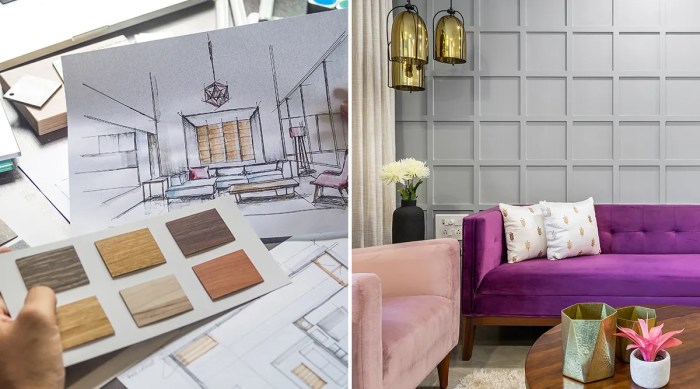Exploring the Role of Architect and Interior Designer 2
Architect and interior designer 2 sets the stage for this enthralling narrative, offering readers a glimpse into a story that is rich in detail and brimming with originality from the outset.
The content delves into the distinct roles, education paths, design processes, and project management responsibilities of architect and interior designer 2, providing a comprehensive view of these professions.
Role of an Architect and Interior Designer
Architects and interior designers play crucial yet distinct roles in the field of construction and design. While architects focus on the overall structure and functionality of a building, interior designers concentrate on creating aesthetically pleasing and functional interior spaces.
Distinguishing Tasks
- Architects are responsible for designing the overall layout and structure of a building, ensuring it meets safety and regulatory standards.
- Interior designers focus on selecting color schemes, furniture, lighting, and decor to enhance the interior space and reflect the client's preferences.
Specific Responsibilities
- Architects create detailed blueprints, conduct site visits, and work closely with engineers and contractors to ensure the structural integrity of a building.
- Interior designers develop mood boards, select materials, and furniture, and collaborate with clients to bring their vision to life within the space.
Comparison in a Construction Project
- Architects are involved from the initial concept and design phase of a project, focusing on the exterior and overall structure.
- Interior designers come into play during the later stages, focusing on the interior aesthetics, functionality, and ambiance of the space.
Education and Training
Becoming an architect or an interior designer requires a specific educational path and training to ensure proficiency in the field.
Architect Education Path
To become an architect, individuals typically need to earn a professional degree in architecture from a school accredited by the National Architectural Accrediting Board (NAAB). This can be a Bachelor of Architecture (B.Arch) or a Master of Architecture (M.Arch) degree.
After completing the degree program, aspiring architects must gain practical experience through internships and pass the Architect Registration Examination (ARE) to become licensed.
Interior Designer Education Path
Interior designers usually pursue a Bachelor's degree in interior design or a related field. Some designers may also have a background in architecture, fine arts, or environmental design. It is essential for interior designers to have a strong understanding of space planning, color theory, and materials.
Many states require interior designers to pass the National Council for Interior Design Qualification (NCIDQ) exam for licensure.
Differences in Training Requirements
While architects focus on the structural and technical aspects of building design, interior designers specialize in creating functional and aesthetically pleasing interior spaces. Architects typically have a more extensive education in building systems, construction, and project management, while interior designers emphasize furniture selection, lighting design, and material finishes.
Importance of Continuing Education
Continuing education is crucial for architects and interior designers to stay updated on the latest trends, technologies, and building codes. It allows professionals to enhance their skills, expand their knowledge base, and maintain their licensure. By participating in workshops, seminars, and courses, architects and interior designers can ensure they are delivering high-quality services to their clients.
Design Process
When it comes to the design process for architects and interior designers, there are several key steps involved that help bring a project from concept to reality. Collaboration between architects and interior designers plays a crucial role in ensuring the overall success of a design project.
Additionally, the tools and software used by professionals in these fields play a significant role in streamlining the design process and bringing their ideas to life.
Steps in the Design Process
Architects and interior designers follow a systematic approach to design that typically includes the following steps:
- Initial Consultation and Research
- Concept Development and Sketching
- Design Development and Planning
- Client Presentation and Feedback
- Finalization of Design Details
- Implementation and Execution
- Project Completion and Evaluation
Collaboration between Architects and Interior Designers
During the design phase, architects and interior designers collaborate closely to ensure that the overall design aligns with the client's vision and meets the functional and aesthetic requirements of the space. This collaboration involves sharing ideas, discussing concepts, and making joint decisions to create a cohesive and harmonious design.
Tools and Software
Architects and interior designers rely on a variety of tools and software to facilitate the design process. Some common tools and software used include:
- Computer-Aided Design (CAD) software for creating detailed drawings and plans
- Building Information Modeling (BIM) software for 3D modeling and project coordination
- Rendering software to create realistic visualizations of the design
- Project management software to track progress and manage tasks efficiently
- Material and finishes libraries to explore and select suitable materials for the design
Project Management

Project management is a crucial aspect of the work of architects and interior designers. It involves overseeing the planning, execution, and completion of a project within the specified scope, budget, and timeline. Let's delve into the project management responsibilities of architects and interior designers, how they coordinate with other professionals, and the challenges they face in this role.
Responsibilities of Architects and Interior Designers
- Developing project timelines and schedules
- Creating project budgets and monitoring costs
- Coordinating with clients to understand their needs and preferences
- Collaborating with engineers, contractors, and other professionals
- Ensuring compliance with building codes and regulations
- Supervising construction activities and resolving any issues that arise
Coordination with Other Professionals
- Regular meetings with engineers, contractors, and suppliers to discuss project progress
- Consulting with structural engineers for input on building designs
- Working closely with lighting designers, furniture manufacturers, and other specialists for interior design projects
- Coordinating with landscape architects for projects involving outdoor spaces
Challenges Faced by Architects and Interior Designers
- Tight project deadlines that require efficient time management
- Managing multiple stakeholders with diverse interests and preferences
- Adapting to unexpected changes in the project scope or budget
- Dealing with construction delays and unforeseen issues on-site
- Balancing aesthetic design goals with practical considerations
Outcome Summary
In conclusion, architect and interior designer 2 play vital roles in shaping spaces and structures, each bringing their unique expertise to the table. This discussion sheds light on the multifaceted nature of their work and the intricacies involved in creating functional and aesthetically pleasing designs.
Answers to Common Questions
What are the distinct roles of an architect and an interior designer?
An architect focuses on the overall design and structure of a building, while an interior designer focuses on the aesthetics and functionality of interior spaces.
What are the typical education paths to become an architect and an interior designer?
Architects usually require a professional degree in architecture, while interior designers often have a degree in interior design or a related field.
How do architects and interior designers collaborate during the design phase?
Architects and interior designers work together to ensure that the overall structure and interior spaces harmonize seamlessly, combining their expertise to create cohesive designs.
What are the common challenges faced by architects and interior designers in project management?
Some challenges include budget constraints, coordinating with other professionals, and ensuring that the design meets client expectations while adhering to regulations.




